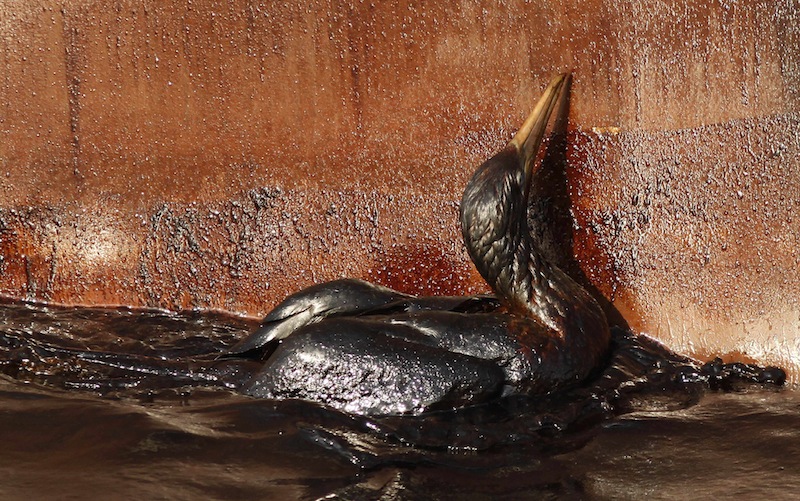NEW ORLEANS (AP) — BP lied to the U.S. government and withheld information about the amount of oil spilling into the Gulf of Mexico after its well blew out in 2010, attorneys told a judge Monday.
But lawyers for the London-based oil giant denied those accusations and said there was no way to prepare for such a unique blowout a mile below the sea floor. Second-guessing the company’s efforts to cap the well was “Monday morning quarterbacking at its worst,” BP attorney Mike Brock said during opening statements of the second phase of a trial over the worst offshore oil spill ever in the U.S.
This part focuses on BP’s response to the disaster and is designed help U.S. District Judge Carl Barbier determine much oil spewed into the Gulf.
The government’s estimate is some 70 million gallons more than what BP says spilled. Establishing how much oil leaked into the Gulf during the 86-day struggle to cap the well will help figure out the penalties the oil company must pay. Billions of dollars are at stake.
The first phase of the trial centered on what caused the blowout.
Brian Barr, an attorney for residents and businesses who claim they were hurt by the spill, said BP failed to prepare for a blowout and compounded the problem by misleading federal officials.
BP had a 600-page oil spill response plan that only included one page on “source control.” It simply called for assembling a team of experts to devise a way to stop a blowout, Barr said.
“BP’s plan was nothing more than a plan to plan,” he said.
BP maintains its spill preparations complied with every government requirement and met industry standards. But the April 20, 2010, blowout of its Macondo well 50 miles off the Louisiana coast presented unforeseen challenges, Brock said. An explosion on the Deepwater Horizon rig killed 11 workers.
In May 2010, BP tried in vain to use the “top kill” method to stop the flow of oil by pumping mud and other material into the blowout preventer. Plaintiffs’ lawyers claim BP knew the strategy was doomed to fail based on higher flow rate estimates that the company didn’t share with federal officials at the time.
“Nevertheless, BP pressed ahead and falsely claimed that it was a slam dunk,” said Brad Brian, an attorney for rig owner Transocean.
A week after the spill started, high-ranking BP official Doug Suttles told Coast Guard Rear Adm. Mary Landry that the company estimated oil was flowing at a rate of 1,000 to 5,000 barrels per day. But the company’s adversaries at the trial say BP’s own internal documents and emails show an effort to conceal much higher estimates.
“BP’s policy of not releasing the flow rate information was enforced at the highest levels of the company,” Brian said, pointing to an email that a BP employee sent to BP Exploration and Production CEO Andy Inglis and his assistant on May 15.
The employee, Mike Mason, warned them that they should be “very cautious” standing behind the lower estimate because his team’s models showed estimates that were up to 20 times higher.
Brian said Mason was called in for a meeting the following day with Inglis’ assistant, who suggested he shouldn’t have put his warning in writing. When Mason asked what the problem was, the assistant replied, “It’s the high number,” according to Brian.
The top kill was among several methods that didn’t work. Other attempts, such as the Cofferdam and the “top hat,” also failed. The terms were obscure industry jargon before the spill but became buzzwords as the company scrambled to find a way to plug the well.
BP insists it was properly prepared to respond to the disaster, but Barr argued the company could have capped the well much sooner if it hadn’t ignored decades of warnings about the risks of a deep-water blowout.
“BP refused to spend any time or money preparing to stop a deep-water blowout at its source,” he said.
BP used a capping stacking to finally stop the gusher on July 15, 2010. Brock rejected the notion that BP could have stopped the spill much sooner if it had a pre-built capping stack on hand. Nobody in the industry had used such a device before, he added.
“It was a unique situation,” he said. “It was a unique blowout.”
Under the Clean Water Act, a polluter can be forced to pay a maximum of either $1,100 or $4,300 per barrel of spilled oil. The higher maximum applies if the company is found grossly negligent, as the government argues BP should be. But the penalties can be assessed at amounts lower than those caps. Congress passed a law dictating that 80 percent of the Clean Water Act penalties paid by BP must be divided among the Gulf states.
The Justice Department’s experts estimate 4.2 million barrels, or 176 million gallons, spilled into the Gulf. BP has urged Barbier to use an estimate of 2.45 million barrels, or nearly 103 million gallons, in calculating any Clean Water Act fines. Both sides agree that 810,000 barrels, or 34 million gallons, was captured before it could pollute the Gulf.
Using the government’s figures, a maximum penalty if the company is found negligent could total $18 billion. Using the company’s figures, that maximum penalty would be around $10.5 billion.
In late July, BP reported a second quarter net profit of $2 billion as lower oil prices, higher taxes and a drop in income from its operations in Russia took their toll on the company. The company has already set aside more than $42 billion for the oil spill, including damage claims from residents and businesses.
Barbier has outlined a rigid schedule for attorneys to present their arguments and evidence over the next four week. A penalty phase for the trial has not been scheduled yet.
Copyright 2013 The Associated Press. All rights reserved. This material may not be published, broadcast, rewritten or redistributed.






